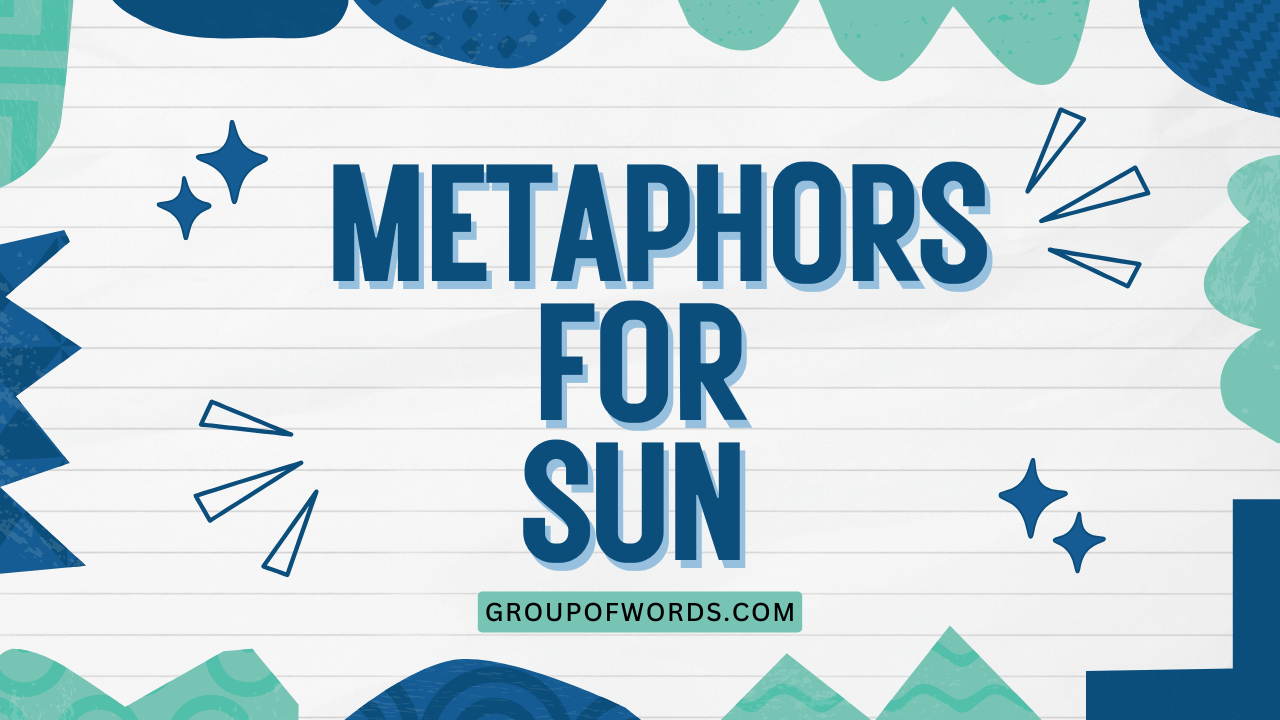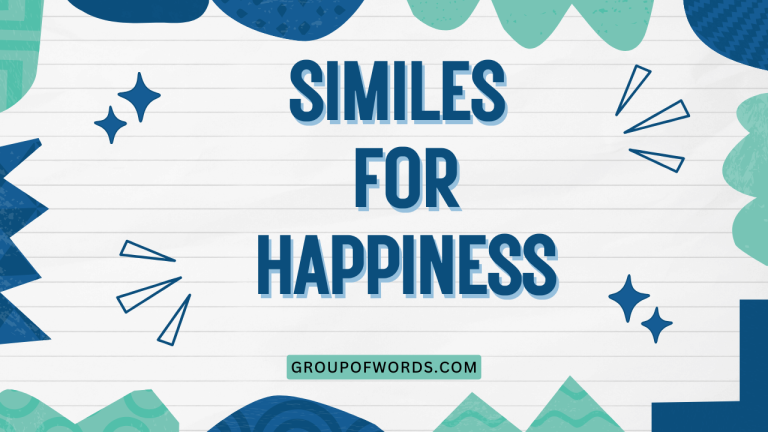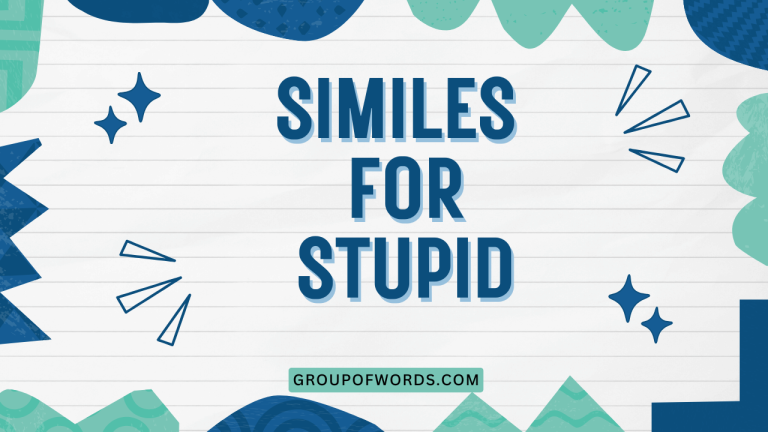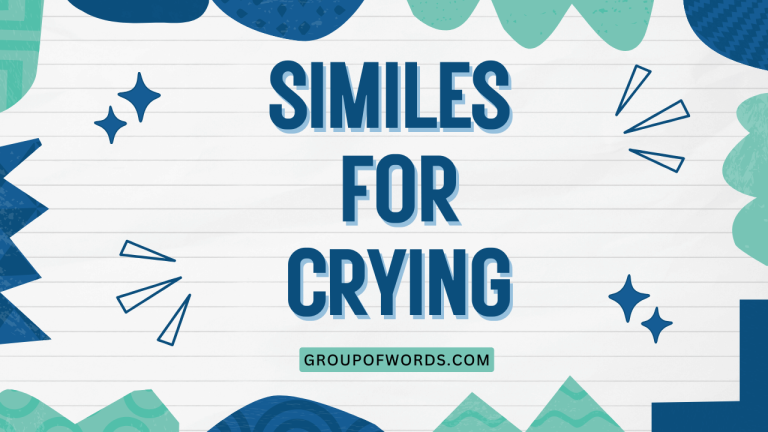Illuminating Language: Metaphors for the Sun in English
The sun, a celestial body of immense power and beauty, has captivated humanity for millennia. As such, it’s no surprise that the sun frequently appears in our language, particularly in metaphors.
Understanding these metaphors enriches our comprehension of English, enhances our writing, and deepens our appreciation for the creative ways we use language to describe the world around us. This article delves into the fascinating world of metaphors for the sun, exploring their types, structures, and usage, providing numerous examples and exercises to help you master this aspect of English grammar and literary expression.
Whether you’re an ESL learner or a native speaker looking to refine your skills, this guide offers valuable insights into the radiant realm of solar metaphors.
Table of Contents
- Introduction
- Definition of Metaphor and Its Application to the Sun
- Structural Breakdown of Solar Metaphors
- Types of Solar Metaphors
- Examples of Solar Metaphors
- Usage Rules for Solar Metaphors
- Common Mistakes When Using Solar Metaphors
- Practice Exercises
- Advanced Topics in Solar Metaphors
- Frequently Asked Questions (FAQ)
- Conclusion
Definition of Metaphor and Its Application to the Sun
A metaphor is a figure of speech that directly compares two unrelated things by stating that one thing is another. Unlike similes, which use words like “like” or “as” to make a comparison, metaphors imply a resemblance or shared quality. The sun, due to its prominent role in our lives and its inherent symbolic weight, is a frequent subject of metaphorical language. These metaphors can describe the sun’s physical characteristics, its effects on the world, or its symbolic representations of concepts like hope, energy, and life.
When we use metaphors for the sun, we are essentially transferring qualities or characteristics typically associated with the sun to something else. This allows us to describe that “something else” in a more vivid, impactful, and often poetic way.
The effectiveness of a solar metaphor lies in its ability to create a clear and resonant connection between the sun and the concept being described, sparking the reader’s imagination and deepening their understanding.
Structural Breakdown of Solar Metaphors
Understanding the structure of metaphors, particularly those related to the sun, involves recognizing the two key elements: the tenor and the vehicle. The tenor is the subject being described (in our case, often something other than the sun), and the vehicle is the sun itself, or a characteristic of the sun, which is used to illuminate the tenor. The connection between the tenor and the vehicle is what creates the metaphorical meaning.
For instance, in the metaphor “Her smile was the sun after a long winter,” the tenor is “her smile,” and the vehicle is “the sun.” The shared quality is warmth, brightness, and the feeling of hope and renewal. The structure can be further analyzed by considering the ground, which is the shared characteristic that justifies the comparison. In this example, the ground includes warmth, brightness, and the ability to bring joy after a period of darkness.
Types of Solar Metaphors
Solar metaphors can be categorized based on the type of association they create between the sun and the subject being described. Here are three common categories:
Personification
Personification involves attributing human qualities or actions to the sun. This can include giving the sun emotions, intentions, or physical capabilities that it doesn’t literally possess.
These metaphors often aim to emphasize the sun’s power, influence, or its role as a life-giving force.
Object Comparison
This type of metaphor compares the sun to other objects, either in terms of appearance, function, or impact. Common comparisons include the sun being described as a ball of fire, a golden orb, or a radiant jewel.
These metaphors often focus on the sun’s physical attributes or its perceived value and importance.
Abstract Concept Association
These metaphors link the sun to abstract concepts such as hope, truth, enlightenment, or energy. The sun’s inherent qualities of brightness, warmth, and life-giving power make it a natural symbol for these abstract ideas.
Such metaphors are often used to convey complex or intangible concepts in a more accessible and relatable way.
Examples of Solar Metaphors
To further illustrate the different types of solar metaphors, here are several examples organized by category:
Personification Examples
The following table provides examples of personification metaphors related to the sun. Notice how each example gives the sun human-like qualities or actions.
| Example | Analysis |
|---|---|
| The sun kissed the earth awake. | The sun is given the human action of “kissing,” suggesting a gentle and loving awakening of the earth. |
| The sun glared down on the parched land. | The sun is described as “glaring,” implying anger or disapproval towards the dry landscape. |
| The sun smiled upon the happy couple. | The sun is described as “smiling,” suggesting approval and joy. |
| The sun wept tears of rain upon the drought-stricken fields. | The sun is given the human emotion of sadness and the action of weeping, symbolizing rain. |
| The sun watched over the sleeping city. | The sun is personified as a guardian, protectively watching over the city. |
| The sun stretched its golden fingers across the horizon. | The sun’s rays are likened to fingers, implying a gentle reach and embrace. |
| The sun stubbornly refused to yield to the approaching storm. | The sun is given the human trait of stubbornness, resisting the storm. |
| The sun whispered warmth into the morning air. | The sun is described as whispering, suggesting a subtle and gentle introduction of warmth. |
| The sun boasted its power in the midday sky. | The sun is given the human trait of boasting, emphasizing its intense power. |
| The sun danced playfully on the surface of the lake. | The sun’s reflection is personified as dancing, suggesting a lively and joyful movement. |
| The sun sighed as it sank below the horizon. | The sun is given the human action of sighing, perhaps suggesting weariness or the end of its day. |
| The sun scolded the late-rising flowers. | The sun is personified as scolding, implying disapproval for the flowers that woke up late. |
| The sun conspired with the clouds to create a dramatic sunset. | The sun is given the human action of conspiring, suggesting a deliberate and collaborative effort. |
| The sun flirted with the moon, creating a breathtaking twilight. | The sun is personified as flirting, implying a playful interaction with the moon. |
| The sun dictated the rhythm of the day. | The sun is described as dictating, emphasizing its control over the daily cycle. |
| The sun narrated the story of the passing seasons. | The sun is personified as narrating, suggesting its role in marking the passage of time. |
| The sun pondered the mysteries of the universe. | The sun is given the human trait of pondering, implying deep thought and contemplation. |
| The sun grumbled behind the thick clouds. | The sun is personified as grumbling, suggesting discontentment or annoyance. |
| The sun giggled as it tickled the leaves with its light. | The sun is described as giggling, implying a playful and lighthearted interaction with the leaves. |
| The sun dreamt of painting the sky with vibrant colors. | The sun is given the human action of dreaming, suggesting creativity and artistic inspiration. |
| The sun embraced the earth with its warm rays. | The sun is personified as embracing, implying a comforting and affectionate gesture. |
| The sun challenged the darkness to a duel of light and shadow. | The sun is given the human action of challenging, suggesting a competitive struggle against darkness. |
| The sun envied the moon’s serene beauty. | The sun is personified as envying, implying a sense of longing or admiration for the moon. |
Object Comparison Examples
The following table illustrates metaphors that compare the sun to various objects, highlighting shared characteristics.
| Example | Analysis |
|---|---|
| The sun was a molten gold coin in the sky. | The sun is compared to a gold coin, emphasizing its color, shape, and preciousness. |
| The sun is a giant spotlight illuminating the stage of the world. | The sun is compared to a spotlight, highlighting its role as a source of light and visibility. |
| The sun was a fiery furnace, baking the desert sand. | The sun is compared to a furnace, emphasizing its intense heat and its effect on the desert. |
| The sun is a celestial diamond, sparkling with brilliance. | The sun is compared to a diamond, highlighting its radiant beauty and value. |
| The sun was a painter’s brush, coloring the clouds with vibrant hues. | The sun’s light is likened to a brush, implying the creation of colorful skies. |
| The sun is a golden globe suspended in the vast expanse of space. | The sun is compared to a globe, emphasizing its shape and its position in the cosmos. |
| The sun was a cosmic bonfire, radiating warmth and light to all. | The sun is compared to a bonfire, highlighting its warmth and its communal aspect. |
| The sun is a lighthouse in the sky, guiding us through the darkness. | The sun is compared to a lighthouse, emphasizing its guiding and protective role. |
| The sun was a massive orange, dripping light across the horizon. | The sun is compared to an orange, emphasizing its color and the way it seems to drip light. |
| The sun is a celestial clock, marking the passage of time. | The sun is compared to a clock, emphasizing its role in regulating the day and night cycle. |
| The sun was a shimmering pearl in the morning sky. | The sun is compared to a pearl, highlighting its beauty and luster. |
| The sun is a giant magnifying glass, focusing its energy on the earth. | The sun is compared to a magnifying glass, emphasizing its ability to concentrate energy. |
| The sun was a celestial artist, painting the sky with breathtaking sunsets. | The sun’s light is likened to an artist, implying the creation of beautiful scenes. |
| The sun is a cosmic mirror, reflecting its light onto the planets. | The sun is compared to a mirror, emphasizing its reflective properties. |
| The sun was a furnace door, opened to release the heat of summer. | The sun is compared to a furnace door, highlighting its ability to release intense heat. |
| The sun is a celestial oven, baking the earth with its warmth. | The sun is compared to an oven, emphasizing its heating effect on the earth. |
| The sun was a giant eye, watching over the world. | The sun is compared to an eye, emphasizing its watchful and observant nature. |
| The sun is a celestial beacon, guiding sailors across the sea. | The sun is compared to a beacon, highlighting its guiding role for navigation. |
| The sun was a spilled pot of gold, scattering light across the landscape. | The sun’s light is likened to spilled gold, implying richness and abundance. |
| The sun is a celestial forge, where energy is created and distributed. | The sun is compared to a forge, emphasizing its role as a source of energy. |
| The sun was a cosmic lantern, illuminating the darkness of space. | The sun is compared to a lantern, highlighting its role in providing light. |
| The sun is a giant prism, refracting light into a spectrum of colors. | The sun’s light is likened to a prism, emphasizing its ability to create colors. |
| The sun was a celestial projector, casting shadows across the earth. | The sun is compared to a projector, highlighting its ability to create shadows. |
Abstract Concept Association Examples
This table presents examples of metaphors that connect the sun to abstract concepts, such as hope, truth, and energy.
| Example | Analysis |
|---|---|
| Her smile was the sun after a long winter. | The smile is associated with the sun’s ability to bring warmth and hope after a period of coldness and darkness. |
| Truth is the sun that illuminates the path to understanding. | Truth is compared to the sun, emphasizing its ability to bring clarity and enlightenment. |
| His energy was the sun powering the team’s efforts. | His energy is compared to the sun, highlighting its energizing and driving force. |
| Love is the sun that nourishes the soul. | Love is compared to the sun, emphasizing its life-giving and nurturing qualities. |
| Inspiration is the sun that ignites creativity. | Inspiration is compared to the sun, highlighting its ability to spark and fuel creativity. |
| Wisdom is the sun that guides us through the darkness of ignorance. | Wisdom is compared to the sun, emphasizing its guiding and enlightening role. |
| Hope is the sun that rises after the darkest night. | Hope is compared to the sun, highlighting its ability to bring light and optimism after difficult times. |
| Courage is the sun that melts away fear. | Courage is compared to the sun, emphasizing its power to overcome and dissolve fear. |
| Knowledge is the sun that shines on the mysteries of the universe. | Knowledge is compared to the sun, highlighting its ability to illuminate and reveal the unknown. |
| Passion is the sun that fuels our dreams. | Passion is compared to the sun, emphasizing its energizing and driving force behind our ambitions. |
| Faith is the sun that warms our hearts in times of doubt. | Faith is compared to the sun, highlighting its ability to provide comfort and warmth during uncertainty. |
| Understanding is the sun that clarifies complex issues. | Understanding is compared to the sun, emphasizing its ability to bring clarity and simplicity. |
| Resilience is the sun that allows us to bloom even after being scorched. | Resilience is compared to the sun, highlighting its ability to enable growth and recovery after hardship. |
| Optimism is the sun that paints a brighter future. | Optimism is compared to the sun, emphasizing its ability to create a positive outlook and vision. |
| Patience is the sun that slowly ripens the fruits of our labor. | Patience is compared to the sun, highlighting its role in nurturing and bringing about the desired results. |
| Kindness is the sun that warms the hearts of those around us. | Kindness is compared to the sun, emphasizing its ability to bring comfort and joy to others. |
| Creativity is the sun that births new ideas and innovations. | Creativity is compared to the sun, highlighting its ability to generate and foster new concepts. |
| Empathy is the sun that allows us to see the world through another’s eyes. | Empathy is compared to the sun, emphasizing its ability to illuminate and provide different perspectives. |
| Forgiveness is the sun that melts away the ice of resentment. | Forgiveness is compared to the sun, highlighting its ability to dissolve negativity and bitterness. |
| Peace is the sun that calms the storms within our souls. | Peace is compared to the sun, emphasizing its ability to bring tranquility and serenity. |
| Clarity is the sun that disperses the fog of confusion. | Clarity is compared to the sun, emphasizing its ability to eliminate uncertainty and ambiguity. |
| Innocence is the sun that radiates purity and simplicity. | Innocence is compared to the sun, highlighting its association with purity and straightforwardness. |
Usage Rules for Solar Metaphors
While metaphors offer creative freedom, it’s important to use them effectively and appropriately. Here are some guidelines for using solar metaphors:
Contextual Appropriateness
Consider the context in which you are using the metaphor. A metaphor that works well in a poem might be inappropriate in a scientific report.
Ensure that the metaphor aligns with the tone, style, and purpose of your writing or speech. A highly elaborate or poetic solar metaphor might feel out of place in a technical document, while a simple, evocative metaphor could enhance a piece of creative writing.
Avoiding Clichés
Some solar metaphors have become overused and cliché. Avoid using phrases like “bright as the sun” or “rays of sunshine” unless you can give them a fresh and original twist.
Strive for unique and imaginative comparisons that will capture the reader’s attention and create a more lasting impression. Think about how you can use the sun in a metaphorical way that hasn’t been done a million times before.
Cultural Sensitivity
Be mindful of cultural associations with the sun. In some cultures, the sun is a symbol of power, masculinity, or divinity, while in others, it may have different connotations.
Ensure that your metaphor is not offensive or insensitive to any particular cultural group. Researching the symbolic significance of the sun in different cultures can help you avoid unintentional misinterpretations or cultural appropriation.
Common Mistakes When Using Solar Metaphors
Here are some common errors to avoid when using solar metaphors:
| Incorrect | Correct | Explanation |
|---|---|---|
| The sun’s heat was like a cold breeze. | The sun’s heat was like a blazing fire. | The comparison should be logical and consistent with the sun’s characteristics. |
| She was the sun, and he was a refrigerator. | She was the sun, and he was the moon, reflecting her light. | The metaphor should create a meaningful connection between the tenor and the vehicle. |
| The sun is a bright light, similar to the sun. | The sun is a beacon of hope in a world of darkness. | A metaphor should offer a fresh perspective, not state the obvious. |
| He runs fast like the sun. | He was a sunbeam, streaking across the field. | This is a simile, not a metaphor. A metaphor states that something *is* something else, not just *like* it. |
Practice Exercises
Test your understanding of solar metaphors with these exercises:
Exercise 1: Identifying Solar Metaphors
Identify the solar metaphors in the following sentences:
| Question | Answer |
|---|---|
| 1. Her wisdom was the sun, illuminating the darkest corners of their minds. | Her wisdom was the sun. |
| 2. The sun is like a giant ball of fire in the sky. | (This is a simile, not a metaphor) |
| 3. The sun, a painter’s brush, splashed colors across the morning sky. | The sun, a painter’s brush. |
| 4. His smile was as warm as the sun. | (This is a simile, not a metaphor) |
| 5. The sun scolded the lazy clouds for blocking its light. | The sun scolded the lazy clouds. |
| 6. The sun is a golden orb that rises each day. | The sun is a golden orb. |
| 7. Their love was the sun, nurturing their growing family. | Their love was the sun. |
| 8. The sun shone brightly like a diamond. | (This is a simile, not a metaphor) |
| 9. The sun’s rays were fingers of light, reaching down to touch the earth. | The sun’s rays were fingers of light. |
| 10. The sun is as hot as a furnace. | (This is a simile, not a metaphor) |
Exercise 2: Creating Solar Metaphors
Complete the following sentences by adding a solar metaphor:
| Question | Answer |
|---|---|
| 1. His hope was _____. | His hope was the sun, breaking through the clouds of despair. |
| 2. Her voice was _____. | Her voice was the sun, warming everyone in the room. |
| 3. Their passion was _____. | Their passion was the sun, fueling their relentless pursuit of success. |
| 4. The truth is _____. | The truth is the sun, revealing all that was hidden in darkness. |
| 5. The artist’s creativity was _____. | The artist’s creativity was the sun, constantly generating new ideas. |
| 6. The leader’s vision was _____. | The leader’s vision was the sun, guiding the team towards a brighter future. |
| 7. The child’s innocence was _____. | The child’s innocence was the sun, radiating pure joy and wonder. |
| 8. The hero’s courage was _____. | The hero’s courage was the sun, melting away the fear of the enemy. |
| 9. The teacher’s knowledge was _____. | The teacher’s knowledge was the sun, illuminating the path to understanding for the students. |
| 10. The athlete’s determination was _____. | The athlete’s determination was the sun, driving them to push beyond their limits. |
Exercise 3: Correcting Incorrect Solar Metaphors
Correct the following sentences to create effective solar metaphors:
| Incorrect | Correct | Explanation |
|---|---|---|
| 1. Her anger was like the sun being cold. | Her anger was the sun, scorching everything in its path. | The corrected metaphor provides a more logical and vivid comparison. |
| 2. The sun is a bright light, just like the sun. | The sun is a beacon, guiding lost souls home. | The corrected metaphor offers a new and insightful perspective. |
| 3. His tears were as shiny as the sun. | His tears were the sun, evaporating his pain. | The corrected metaphor provides a more logical and vivid comparison. |
| 4. The sun is bright like a star. | The sun is the heart of the solar system, pumping life into all the planets. | The corrected metaphor offers a new and insightful perspective. |
| 5. The building was hot, similar to the sun. | The building was a furnace, baking under the relentless sun. | The corrected metaphor provides a more logical and vivid comparison. |
| 6. The sun is a yellow color, like a lemon. | The sun is a painter’s palette, blending colors across the sky. | The corrected metaphor offers a new and insightful perspective. |
| 7. Her love was strong, similar to the sun. | Her love was the sun, warming his soul from the inside out. | The corrected metaphor provides a more logical and vivid comparison. |
| 8. The teacher was very smart, like the sun. | The teacher was the sun, illuminating the minds of her students. | The corrected metaphor offers a new and insightful perspective. |
| 9. The athlete was fast, like the sun. | The athlete was a sunbeam, darting across the finish line. | The corrected metaphor provides a more logical and vivid comparison. |
| 10. The song was happy, similar to the sun. | The song was the sun, chasing away the shadows of sadness. | The corrected metaphor offers a new and insightful perspective. |
Advanced Topics in Solar Metaphors
For advanced learners, here are some more complex aspects of using solar metaphors:
Extended Metaphors
An extended metaphor is a metaphor that is developed over several lines or paragraphs. This allows for a more detailed and nuanced comparison, creating a richer and more complex image in the reader’s mind.
For example, a poem could use the sun as an extended metaphor for hope, exploring various facets of hope through different aspects of the sun’s behavior and characteristics throughout the poem.
Mixed Metaphors
A mixed metaphor combines two or more incompatible metaphors, often creating a humorous or nonsensical effect. While sometimes used intentionally for comedic effect, mixed metaphors are generally considered a sign of unclear thinking or poor writing.
For example, “The sun is a beacon of hope that’s also a sinking ship” is a mixed metaphor because a beacon of hope and a sinking ship convey contradictory ideas.
Frequently Asked Questions (FAQ)
Here are some frequently asked questions about metaphors for the sun:
- What is the difference between a metaphor and a simile?
A metaphor directly states that one thing is another, while a simile uses “like” or “as” to make a comparison. For example, “He is the sun” (metaphor) versus “He is like the sun” (simile).
- Why are metaphors important in writing?
Metaphors add depth, imagery, and emotional resonance to writing. They help readers understand complex ideas in a more relatable way and make writing more engaging and memorable.
- How can I avoid using clichés when creating solar metaphors?
Think outside the box and look for unique and unexpected connections between the sun and the concept you’re describing. Consider less common aspects of the sun, such as its role in photosynthesis or its impact on different environments.
- Are solar metaphors universally understood?
While the sun is a common symbol across many cultures, its specific associations can vary. Be mindful of cultural differences and avoid using metaphors that might be misinterpreted or offensive.
- Can a single sentence contain multiple metaphors?
Yes, but use caution. Too many metaphors in one sentence can become confusing or overwhelming. Ensure that each metaphor contributes meaningfully to the overall message.
- How do I know if a solar metaphor is effective?
An effective solar metaphor should be clear, evocative, and relevant to the context. It should create a strong and memorable image in the reader’s mind and enhance their understanding of the subject.
- What are some other celestial bodies that are often used in metaphors?
Besides the sun, the moon, stars, and planets are frequently used in metaphors. Each celestial body carries its own unique set of associations and symbolic meanings.
- How can I improve my ability to create effective metaphors?
Read widely, pay attention to how other writers use metaphors, and practice creating your own. Experiment with different types of metaphors and ask for feedback on your work.
Conclusion
Mastering metaphors for the sun can significantly enhance your understanding and use of the English language. By understanding the different types of solar metaphors, their structural components, and the rules governing their usage, you can create more vivid, impactful, and engaging writing.
Remember to consider the context, avoid clichés, and be mindful of cultural sensitivities when crafting your own solar metaphors. Practice regularly and seek feedback to refine your skills.
The sun, as a symbol of life, energy, and hope, offers a rich source of inspiration for metaphorical expression.
By exploring the radiant realm of solar metaphors, you not only improve your grammatical skills but also deepen your appreciation for the creative and expressive power of language. Continue to observe, analyze, and experiment with metaphors to unlock your full potential as a writer and communicator.
Let the sun be your guide as you illuminate your words with brilliance and imagination.






